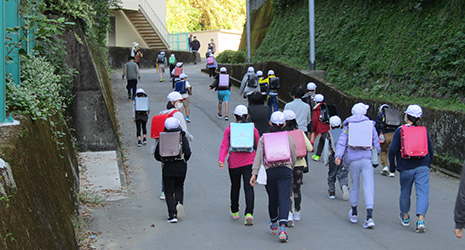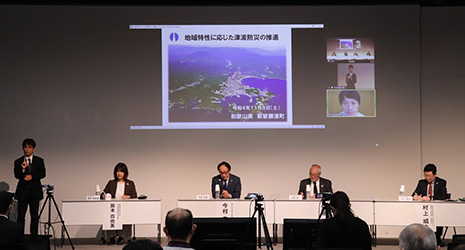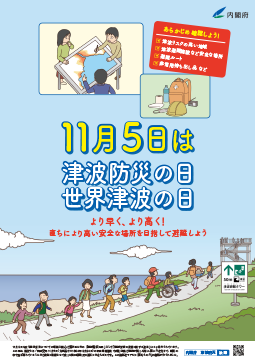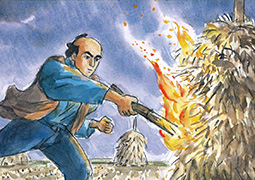November 2022
- English
- 日本語
Japan’s Initiatives to Promote Tsunami Preparedness

Tsunami evacuation drill at Nachikatsuura Town, Wakayama Prefecture 
“Tsunami Preparedness Day” special event

Posters advertising “Tsunami Preparedness Day” and “World Tsunami Awareness Day” on November 5 
From a picture-story show of “Inamura no Hi,” showing the scene where the protagonist sets fire to inamura (rice sheaves)

On Tsunami Preparedness Day and World Tsunami Awareness Day, or November 5, a number of tsunami preparedness initiatives are implemented across Japan.

The Act on Promotion of Tsunami Countermeasures was enacted in June 2011 in order to comprehensively and effectively promote tsunami countermeasures in Japan. This law stipulates initiatives such as strengthening the monitoring system and promoting research and study for tsunami countermeasures, education and training in tsunami preparedness, and providing facilities necessary for tsunami countermeasures. Moreover, in order to deepen the general public’s understanding of and interest in tsunami countermeasures, it was also stipulated that November 5 would be designated as “Tsunami Preparedness Day,” in memory of the story of “Inamura no Hi” (The Fire of Rice Sheaves), a life-saving event which occurred on the same date in 1854 (see box article).
Furthermore, the United Nations General Assembly convening in December 2015 decided to designate November 5 as World Tsunami Awareness Day following a joint proposal by 142 countries, including Japan.

Initiatives such as holding tsunami evacuation drills are taken throughout Japan every year around November 5 to prepare against tsunamis and raise awareness of disaster preparedness. On November 5 this year (2022), the “Tsunami Preparedness Day Special Event” was held, attended by Mr. Tani Koichi, Minister of State for Disaster Management and Ocean Policy. At that event, the keynote speech was given by Imamura Fumihiko, Director and Professor of the International Research Institute of Disaster Science (IRIDeS), Tohoku University, who described tsunami evacuation best suited to local characteristics based on lessons learned from the Great East Japan Earthquake. After that, presentations were given by officials from Nemuro City, Hokkaido Prefecture and Nachikatsuura Town, Wakayama Prefecture, which face the Pacific Ocean with high tsunami risk, to report their tsunami preparedness initiatives with high consciousness such as “No one left behind,” and a panel discussion followed with experts in the field.
A tsunami is a type of disaster in which human casualties can be greatly mitigated through prompt and appropriate evacuation. It is important on Tsunami Preparedness Day to remind ourselves of the characteristics of tsunamis and appropriate tsunami countermeasures so that we can take immediate action and save our lives after an earthquake.
Note: This article has been created with the consent of the Cabinet Office and on the basis of materials published by the Office.
Inamura no Hi* (The Fire of Rice Sheaves)

The Ansei-Nankai Earthquake and subsequent tsunami that occurred on November 5, 1854 (old calendar of Japan**) caused enormous damage and loss of life in the Kansai region and Shikoku region. In present-day Hirokawa Town, Wakayama Prefecture, a businessman Hamaguchi Goryo (1820–1885) led many villagers to a safe place after the earthquake by setting fire to inamura (rice sheaves) so that those escaping the tsunami would not lose their way in the dark.
After the disaster, Hamaguchi built housing for the victims, provided food and other supplies, and supported the construction of an embankment, which had a total length of 600 meters and height of 5 meters, to protect the village from tsunamis.
Taking a hint from this true story, the literary scholar Koizumi Yakumo (Lafcadio Hearn***, 1850–1904) wrote a short story, “A Living God,” in 1896. In addition, Nakai Tsunezo (1907–1994), an elementary school teacher who was moved by this story, created a Japanese-language teaching material titled “Inamura no Hi,” which was a translation and retelling of the story for elementary school pupils. Since then, “Inamura no Hi” has continued to remind children about the importance of early evacuation after an earthquake, appearing in various forms such as manga and picture-story shows as a disaster preparedness teaching material. Moreover, the Asian Disaster Reduction Center, based in Hyogo Prefecture, has created and distributed tsunami preparedness teaching materials using “Inamura no Hi” in multiple languages.**** (For more details, see https://www.tokeikyou.or.jp/bousai/inamura-top.htm)
* See Highlighting Japan March 2015, “Inamura no Hi” https://www.gov-online.go.jp/eng/publicity/book/hlj/html/201503/201503_09_en.html
** Old calendar of Japan (lunisolar calendar) is based on the phases of the moon and the cycles of the sun. It was used in Japan until 1872. Compared to our calendar today, it is about one month off.
*** Lafcadio Hearn was born in Greece. He came to Japan in 1890 and taught English and English literature in middle schools and universities. He produced many works such as translations, travelogues, and retellings of folk tales.
**** https://www.adrc.asia/publications/inamura/top.htm

